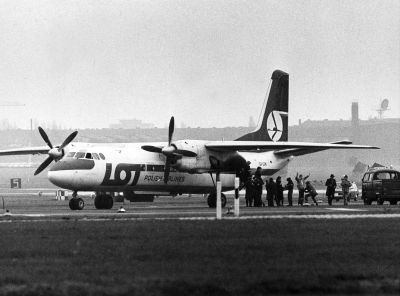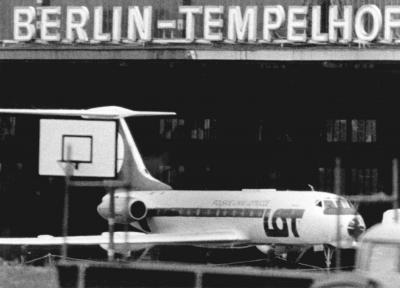LOT in Tempelhof

There were also a great many jokes in Poland about the numerous airline hijacks, viz. “a passenger boards a LOT flight in Warsaw. Before the takeoff he asks the pilot what the destination is. “Breslau” is the snappy answer. The passenger pulls a face and replies “Yeah, yeah. That’s what the other three pilots told me, and every time I landed in Tempelhof”.”
It’s easy to smile about such jokes but the hijacks bore witness to the fate of many people who were suffering from the political and economic situation in Poland. The greatest wave of hijacks occurred during the years shortly before and after the introduction of martial law in Poland. Many people risked their lives, their existence and their future to flee from socialist Poland. These included individuals, complete families, groups of friends, Polish pilots and even, in the 1980s, armed air-traffic control officials.
On Friday 30th April 1982 fifty-four passengers in Warsaw boarded a LOT aircraft (type An-24) to fly to Wrocław (Breslau). 36 of them already knew in advance where they wanted to fly because they had been briefed that the plane was to be hijacked to Nuremberg. They were not armed, but very well-prepared. Several of them had already flown the route between Warsaw and Breslau on many occasions in order to acquaint themselves with the precise situation on board. In this way they had discovered the exact position where the two plain-clothes militia officials would be sitting. (Because there were so many hijacks at the start of the 1980s, it was standard procedure to place security officials and soldiers from a special unit on board.) But the hijackers were also well acquainted with the working procedures of the staff and pilots. They had deliberately planned and chosen 30th April as their date, because 1st May was a socialist public holiday when the attention of the state was completely focussed on preparations for the celebrations. Twenty minutes after takeoff the plotters surprised the officers. One of the hijackers forced his way into the cockpit and ordered the pilots to change their destination to Germany. But there was not enough fuel for them to fly to Nuremberg. The alternative was West Berlin. Despite military threats from two Soviet fighters in the air space over the GDR the LOT machine landed safely in Tempelhof.
After the introduction of martial law Czesław Kudłek, a pilot employed by LOT, was afraid that he would be replaced by military pilots. When he lost his flat in Warsaw and was forced to move to Breslau the situation for his family reached a crisis point. As a result he decided to flee from Poland. On 12th February 1982 he was assigned to pilot a LOT flight from Warsaw to Breslau. There were nineteen passengers on board including his own family and some friends, (parachute jumpers and pilots) whom he had also persuaded to flee. He was dependent on outside help because there were at least four officials sitting on the plane who were responsible for security. At first he managed to persuade them that the change in flight direction was a necessity because military exercises in Breslau made it impossible to land there, and this required him to divert to Szczecin (Stettin). Czesław Kudłek then informed the control tower in Warsaw that the plane had been hijacked. The security officials on board only became suspicious when two East German fighter aircraft and a Soviet combat jet came up alongside the plane in GDR airspace, at which point the officials were overpowered by the passengers. Nonetheless the danger from the fighter aircraft was still present. That said, Czesław Kudłek was an experienced pilot. At first he headed for Schönefeld airport in East Berlin, and when the MiGs noticed this, they withdrew. Shortly before Schönefeld Kudłek flew over the control tower, crossed East Berlin and landed in Tempelhof.
On 22nd November 1982 the pilot Jerzy Mikula was surprised in his cockpit by a hijacker who demanded to be flown to Tempelhof. This was no less than the third time he had experienced a hijack. But this time the hijacker was a twenty-two-year-old ZOMO official (Zmotoryzowane Obwody Milicji Obywatelskiej /the Motorised Reserves of the Civilian Militia), who was responsible for onboard security. He was even an instructor specialising in aircraft hijacks. Although he was carrying a weapon, several grenades and a parachute, thankfully he used none of them. The second official on-board only noticed the situation in Berlin but by then it was too late. Despite shooting the hijacker in the heel he was unable to stop him fleeing to the West.
These are only a few of the fates of the huge amount of people involved in the aircraft hijacks or escapes, depending on which way you define such things. There were also many attempts to escape on board smaller aircraft not belonging to LOT. A huge number of these were unsuccessful. Some of them were stopped before they even took off and some were turned back in the air. Whatever the case, punishment and repression awaited the potential refugees and their families.
Tempelhof airport is not only still a symbol of freedom for Polish citizens. Although there are no more landings here, let alone hijacks, the huge site now belongs to the citizens of Berlin. Here they can find a place of recreation in which to stroll, jog and skate. Today it is very difficult to imagine that today’s “Tempelhof Park” was once the site of dramatic flights from the People’s Republic of Poland.
Nowadays LOT lands completely legally at Berlin-Tegel, but no one jokes about them “landing a lot in Tegel”. This is also a sign of the huge change in European relations during the past few decades.
Adam Gusowski, January 2016
Additional information:
The police files and press collections in the National archive in Berlin refer to 16 LOT aircraft that were hijacked to Tempelhof. By contrast, in the Tempelhof Air Force archive there are references to only eight hijacked LOT aircraft (in addition to 4 Polish aircraft not belonging to LOT).

